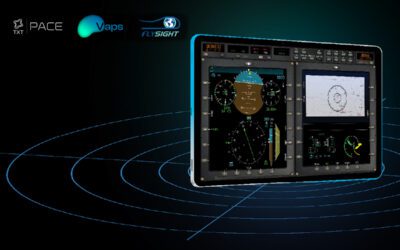Rather than developing and implementing single systems, the way forward for avionics missions systems is modular. To that end, Modular Open Systems are by far the most practical and adaptable solutions to creating bespoke systems.
In this article, we will explore the Modular Open System Approach (MOSA), its implications for avionics, its benefits, and a breakdown of how the system works. We’ll also discuss how other systems can be grandfathered to integrate into a MOSA construction and what it could mean for the future of aircraft mission consoles.
What is MOSA?
MOSA, or Modular Open System Approach, is an integrated business and technical strategy. Used mainly by the military and the DoD, it enables users to design and build an affordable and adaptable system. The principle’s modular nature means that, due to the network’s open standards nature, it can be customised to suit the end user’s exact requirements.
The result is a highly cohesive system structure that is easily updateable, more cost-effective, and can be adapted to suit the changing parameters of the user’s requirements. This ensures that obsolescence is avoided and prevents operational conflicts due to non-compatible modules. The critical element is the use of an Open System approach.
While at first glance this may appear vulnerable to outside interference, the truth is that the term ‘Open System’ is a bit of a misnomer. MOSA is, in fact, a highly secure system that offers operators a ‘Plug-and-Play’ construction for a myriad of different operational requirements.
It is essential to bear in mind that MOSA is not in itself a technical standard but rather an acquisition and design strategy that prioritises the use of open standards-based technology to create affordable and adaptable systems. Because of the inherent practicalities of this approach, it is now the preferred method to create open systems not just for the US DoD but for the whole of NATO. This results in a cohesive and uniform approach to modular design, particularly for avionic platforms.
A legal requirement in the US
As well as making practical sense, it is also worth noting that MOSA is a legal requirement in the USA under Title 10 US Code 2446a.(b), Sec 805 of DoD Acquisition Regulations. Not only does this effectively create a legal framework for creating MOSA-compatible systems, but it puts everyone on the same level, knowing that modular-based systems have to strive to achieve the same standards in engineering, universal compatibility and design.
The business aspect of MOSA
That last point is vital when looking at the business and commercial side of avionic modular systems. MOSA encourages providers not just to produce hardware and software that can be easily interfaced with other elements but also promotes transparency and collaboration. Everyone has to reach a set standard, and this benchmark applies to all contractors, suppliers and developers such as FlySight. The result is a far more cohesive approach to modular development that benefits everyone.
What systems can operate using MOSA standardisation?
MOSA’s entire purpose is to create a standardised approach to modular operating systems that also conforms with the requirements of the DoD and now also NATO. This includes all branches of the military, including the Army, Navy and Air Force. For aerial platforms in particular, the modular approach is particularly relevant due to the limitations on size and weight. Currently, the standards include:
- OMS (Open Mission Systems) is primarily applicable to military aviation weapons systems, services, and subsystems, but it could also be included in SAR operations, surveillance, and intelligence gathering.
- FACE (Future Airborne Capability Environment) – MOSA enables systems for aircraft systems software to be futureproofed, not by creating definitive systems but by ensuring that those developed can be seamlessly incorporated as upgrades
- OpenVPX / VITA – the DoD and NATO use a broad range of electronic hardware systems, all of which need to be developed with MOSA principles of compatibility at their core
- MORA (Modular Open RF Architecture) – some MOSA development is mission-specific, such as MORA. This is designed to extend and maximise radio frequency capabilities, as well as make them more flexible and adaptable to multiple scenarios
- VICTORY (Vehicle Integration for C4ISR/EW Interoperability) – this network/intra-platform standard is exceptionally important for multiple vehicle constructs to ensure that all vehicles are running the same compatible systems
- Redhawk – this is a specific framework for software-defined radio (SDR). It is crucial, when surrounded by cutting-edge technology, not to underestimate the importance of radio communication, especially between multiple operating platforms such as ground and aerial, ROVs, and onshore-offshore communications.
- CMOSS (C5ISR/EW Modular Open Suite of Standards) – includes FACE, VPX/VITA, MORA, VICTORY, Redhawk, and others
- WOSA (Weapon Open Systems Architecture) – a mission-critical framework for munitions development and operations.
Real-world applications of MOSA
Throughout this process, we need to remember that MOSA isn’t a tangible product but rather a methodology. There is no such thing as a MOSA ‘box’, plug-in, or single turnkey solution. Instead, MOSA is a series of modular decisions based on specific objectives. So, applying MOSA to a real-world scenario will depend on several factors.
For example, the system has already been applied to SAR operations along the south coast of England. Covering one of the busiest shipping lanes in the world – one regularly used as a route by unauthorised small boats from the continent – means a higher-than-average number of helicopter scrambles every year.
By integrating a MOSA approach, those scrambles have dropped dramatically, saving time and resources and reducing the financial outlay. The reduction was achieved using a Schiebel S-100 Camcopter uncrewed aircraft system. By utilising a MOSA approach, SAR takes on a more modular structure that uses different components to perform various elements of the mission.
This methodology can be transposed onto a variety of other scenarios, from SAR in the English Channel to oil and gas platform inspection, as well as connecting airborne units with lifeboats or response vessels. By ensuring all agencies, including the Civil Aviation Authority, are on the same page through a MOSA approach and integrated hardware and software, financial savings can be made, and the operational success rate will be higher as the process becomes more streamlined and effective.
How MOSA can be integrated successfully into aircraft mission systems
We have already discussed how modular open systems architecture is a practical methodology for airborne units. There are a few additional advantages that we haven’t yet mentioned, not least of which is the ability to remove mission consoles and insert them into a variety of aircraft with minimal ground time or fuss.
The flexibility of a MOSA approach means that advanced interoperability between aircraft extends not only their operational capabilities but also their financial feasibility.
Strategically speaking, the MOSA modular open systems approach makes sense. It represents a more joined-up-thinking methodology and is particularly suitable for modern combat situations that do not follow conventional formulations.
Its application in other roles (such as surveillance, law enforcement, and SAR) also makes this approach a far more effective and versatile way of tackling common, technologically challenging, or one-off operational issues. It represents a synergistic approach to operations, ensuring a more effective use of resources, both mechanical and human.
Aircraft mission systems form the foundation of operational procedure, linking both manned and unmanned units with ground control operations. With MOSA, cross-border operations can proceed effectively because everyone uses the same methodology and technology that meets the stated parameters for interoperability. These systems work together rather than independently, making them far more effective in joint operations or solo missions.
How OPENSIGHT fits in with the MOSA principle
OPENSIGHT is a multi-platform PED (Processing, Exploitation, and Dissemination) system created to provide the best support in decision-making. It features independent platforms with modular plug-ins, each exportable as a stand-alone application or library.
The system is fully customisable through simple software development kits for specific applications while still maintaining that generic compatibility with both internal and external systems. The result is a turnkey solution that is intuitive, easy to use, and provides users with a bespoke operating system fully integrated into existing hardware that users are familiar with.
Is a modular open systems architecture the way forward?
Put simply, yes. Rather than having a multitude of closed systems that are unable to interoperate or work within cross-platform scenarios, MOSA ensures that everyone is, quite literally, “on the same page”. The result is the development of mission computers in aircraft, ROVs, ground units and ocean-going craft that can talk to one another.
OPENSIGHT is a modular system designed to fit in with the legacy approach and make it even more integrable. To find out how OPENSIGHT has a future within MOSA architecture, take a look at our video library or talk to one of our advisors today.





